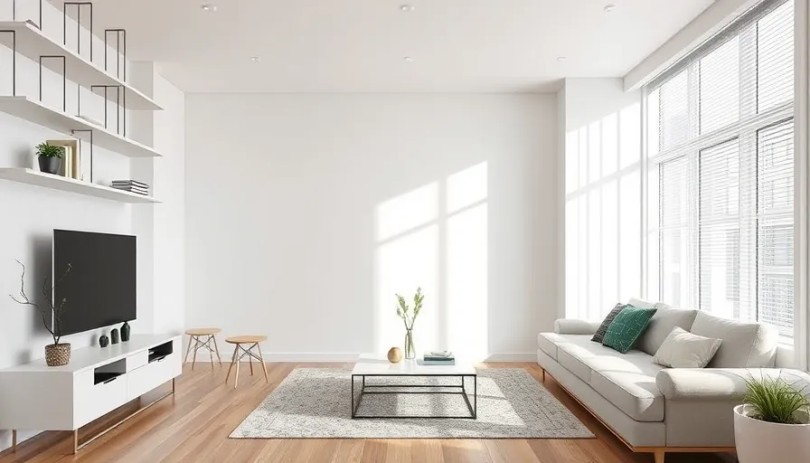Helpful information
30 August 2024
What is pre-finishing of an apartment (white box)

When purchasing real estate directly from a developer, some investors opt for properties with pre-finishing. We suggest figuring out what pre-finishing is, how it differs from other stages of renovation work and, most importantly, whether it is possible to move into such an apartment immediately.
What is pre-finishing
Pre-finishing or white box is an intermediate stage of renovation work between rough and fine finishing. Today, this type of housing readiness from the developer is becoming increasingly popular, as buyers like that all the rough and dirty work has already been done.
Pre-finishing or, as it is also called, semi-finishing, declared by the developer, means that you get apartments divided by partitions into separate rooms, with utility networks distributed throughout the rooms, floor screed, putty walls and ceilings.
Such housing is visually white, which is why it is called a "white box". The only exception is the places where wires for connecting switches, sockets, and lamps exit the walls and floor. In fact, it is possible to bring a room from a pre-finishing state to a complete finishing renovation in just a couple of weeks.
Some market experts note that there is no standard as such that defines the list of works within the pre-finishing stage. That is, construction companies can themselves determine the set of options included in this stage of renovation. Therefore, we recommend that before purchasing an apartment, you clarify with the developer what exactly is included in the semi-finishing in a new building.
High-quality pre-finishing has a number of undeniable advantages:
- All the dirty work is done, and the owners no longer need to deal with issues of removing construction waste.
- Optimization of financial costs for apartment renovation, since often rough and pre-finishing done by the developer are cheaper than the same amount of work done by the owner independently. For example, cooperation with manufacturers, due to the huge scale of work, gives developers the opportunity to purchase materials for construction and finishing at wholesale prices.
- Saving both money and time, and, most importantly, nerves. Owners who have already had experience in independent repairs will unconditionally support the above.
- Pre-finishing in an apartment is the stage of repair at which it is still possible to make the desired adjustments or fully implement an individual design project.
- If the developer has provided white box finishing in the apartments of a residential complex, then basically this stage is implemented in parallel in all apartments. That is, you will not have to endure the noise and dirt that accompany any rough repair of housing.
As for the disadvantages of pre-finishing repairs, the main one is the quality of the work performed. Not all developers are guided by the goal of obtaining an exceptionally good result. In some cases, the priority is the deadline for the delivery of the object and budget savings. Therefore, buyers should be careful when choosing a construction company.
There are no other significant disadvantages to pre-finishing. Rather, there are several features that may not suit certain categories of investors, namely:
- If we are talking about redevelopment, any unusual zoning of housing at the stage of pre-finishing, then the owner will have to spend additional money on the work.
- The next day after the conclusion of the purchase and sale agreement, it will not be possible to move into the apartment or rent it out. It will take some time to complete the renovation.
What is the difference between rough, pre-finishing and finishing
The key difference between rough, pre-finishing and finishing in new buildings is the definition of each of the listed types of renovation work.
Rough finishing is the stage at which the housing essentially has not yet been renovated. That is, the apartment has utilities (water, gas, sewerage, electricity), there is a screed on the floor, window frames are inserted, in some cases there is rough plaster on the walls and ceiling.
Finished finishing is the final renovation, after which you can immediately move into the apartment. The following repairs have been completed: floor and ceiling coverings, tiles and plumbing in the bathrooms and kitchen, wallpaper, interior and entrance doors, double-glazed windows, sockets and lighting fixtures, i.e. before moving in, residents will only need to purchase household appliances, furniture and decorative items.
Pre-finishing, as we have already mentioned, is an intermediate stage between rough and final repairs. The main difference between pre-finishing and final repairs is that in the first case, the premises are prepared for final decorative work, and in the second case, an interior ready for living is created.
What does pre-finishing of an apartment in a new building include?
The developer's range of finishing works for apartments includes:
- High-quality leveling of the ceiling and walls, for which plasterboard sheets or plaster are used. The better the surfaces are leveled and primed, the better the decorative finishing materials will lie on them. At the stage of pre-finishing, puttying of the walls is also mandatory.
- Floor leveling is another mandatory option for pre-finishing repairs. The surface must be fully prepared for laying durable flooring. As a rule, concrete screed is used as a leveling material.
- Electrical wiring installation work, which includes wall chasing and wiring, lighting cable routing, switch installation, and wall boxes. All safety requirements are met.
- Plumbing work on installing toilets, sinks, bathtubs or shower stalls in bathrooms, drain pipes, and shut-off valves. In addition, at this stage, the connection to the sewerage and water supply systems is made, taking into account all applicable standards.
- Interior and entrance doors are installed. Sometimes buyers decide to replace the entrance doors with more reliable ones. But even in this case, the quality of the doors in the apartment depends entirely on the developer.
- Final window finishing — in addition to window units, all work on installing window sills and leveling slopes is performed.
- If the apartment has heating, at the pre-finishing stage, piping is laid, batteries and a boiler are installed, or underfloor heating is installed.
These are the main types of work in the white box format, after which the new apartments are considered completely ready for finishing.
How long does pre-finishing take?
The good news is that pre-finishing takes only ¼ the time allotted for repair work in the apartment from the developer. At this stage, the property will be transformed every day, acquiring more and more characteristics of real estate ready for occupancy.
As for the time required for pre-finishing, several factors play a role in this case, in particular, the area of the apartment. On average, pre-finishing works last:
- in one-room apartments - 30-40 days;
- in two-room apartments - 40-50 days;
- in three-room apartments - 50-60 days.
In addition to the square footage of the room, the materials used affect the pre-finishing time. If these are simple and quick-to-install materials, such as laminate, paint, wallpaper, then the work will move fairly quickly. If a more complex and expensive finish is planned using parquet, tiles, and various decorative plasters, then installation will require attention to detail, strict adherence to technology, and therefore will take more time.
What is done after pre-finishing
After pre-finishing, home renovation enters the home stretch — finishing. Finishing includes:
- Laying tiles. As a rule, tiles are laid at the pre-finishing stage, and all finishing work on grouting can be carried out during the finishing renovation.
- Painting the ceiling and walls, wallpapering. The modern market offers buyers a wide range of finishing materials, but simple painting of walls and ceilings, wallpapering are still very relevant today.
- Laying flooring. If all work was done well at the rough and pre-finishing stage, then there will be no problems with laying the floor covering.
- Installing doors. Doors are installed after the walls (finish painting or wallpapering) and floor are fully ready.
- Installation of plumbing. In modern apartments, developers provide for the installation of shower cabins, bathtubs, toilets, heated towel rails and other devices, which are then connected to utilities.
- Installation of finishing electrical wiring. This includes the installation of protective equipment, sockets, switches, thermostats for underfloor heating, lamps and other electrical appliances.
It is important that most of the listed works, which are carried out after pre-finishing, can be carried out simultaneously, which significantly speeds up the complete completion of the repair.
Is it possible to live in an apartment with pre-finishing?
If we consider this issue in relation to the presence of a “roof over your head”, then theoretically it is possible to live in an apartment with pre-finishing. However, if we take into account the level of comfort, the situation is ambiguous. Yes, in a white box most of the repair work has already been completed, but:
- There is no finishing coating, which means that white walls and a floor covered with screed create a feeling of an uninhabited, uncomfortable room.
- The dust and dirt left behind by the builders will settle on all objects in the apartment.
- Inconveniences during cleaning cannot be avoided: you must admit that dust on bare walls and floors is much more difficult to wash off than from laminate or tiles.
So, living in an apartment with pre-finishing is an option exclusively for owners who simply have nowhere else to live and they want to finish the finishing repairs themselves in order to move into a new home as quickly as possible.
Read also



